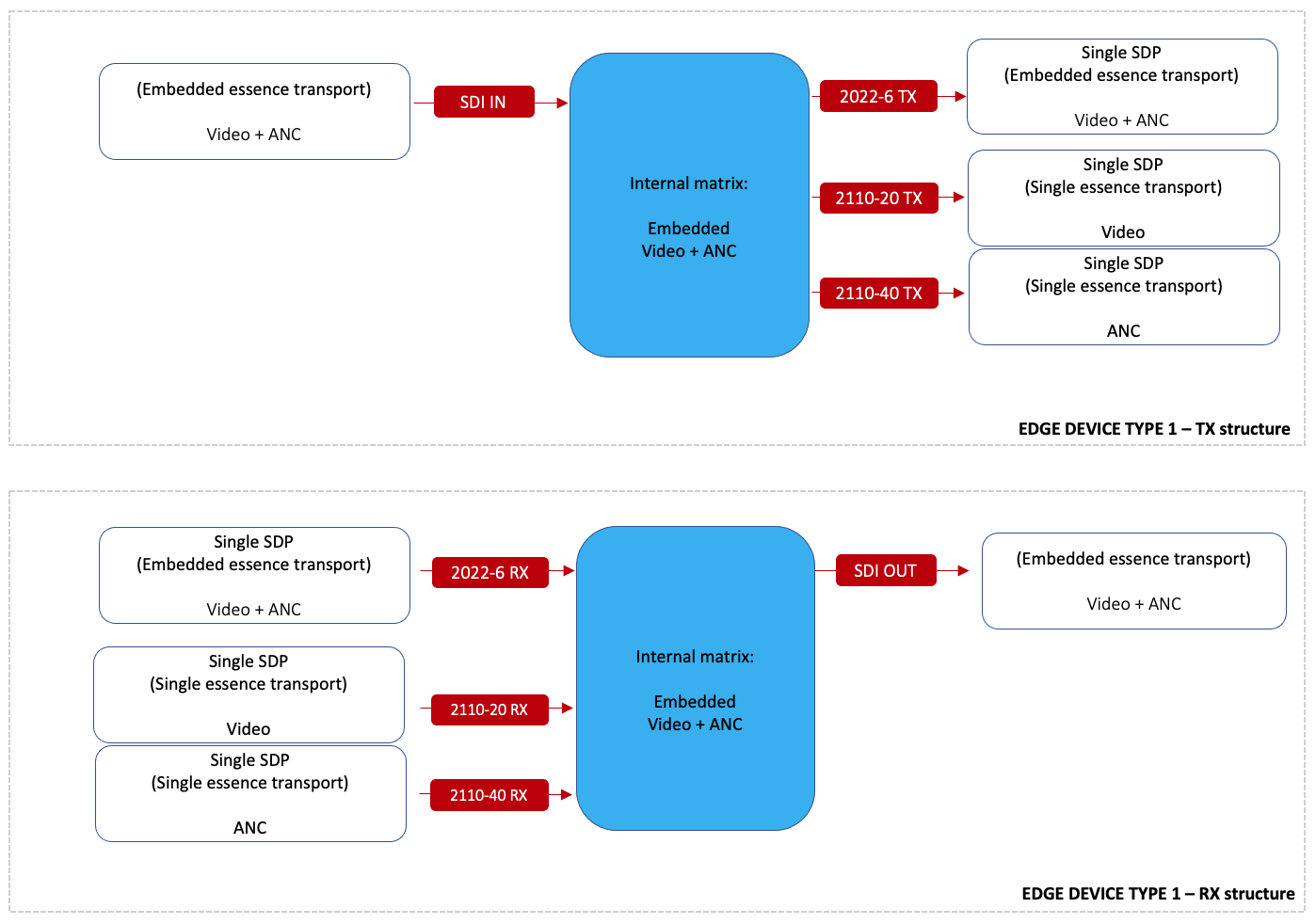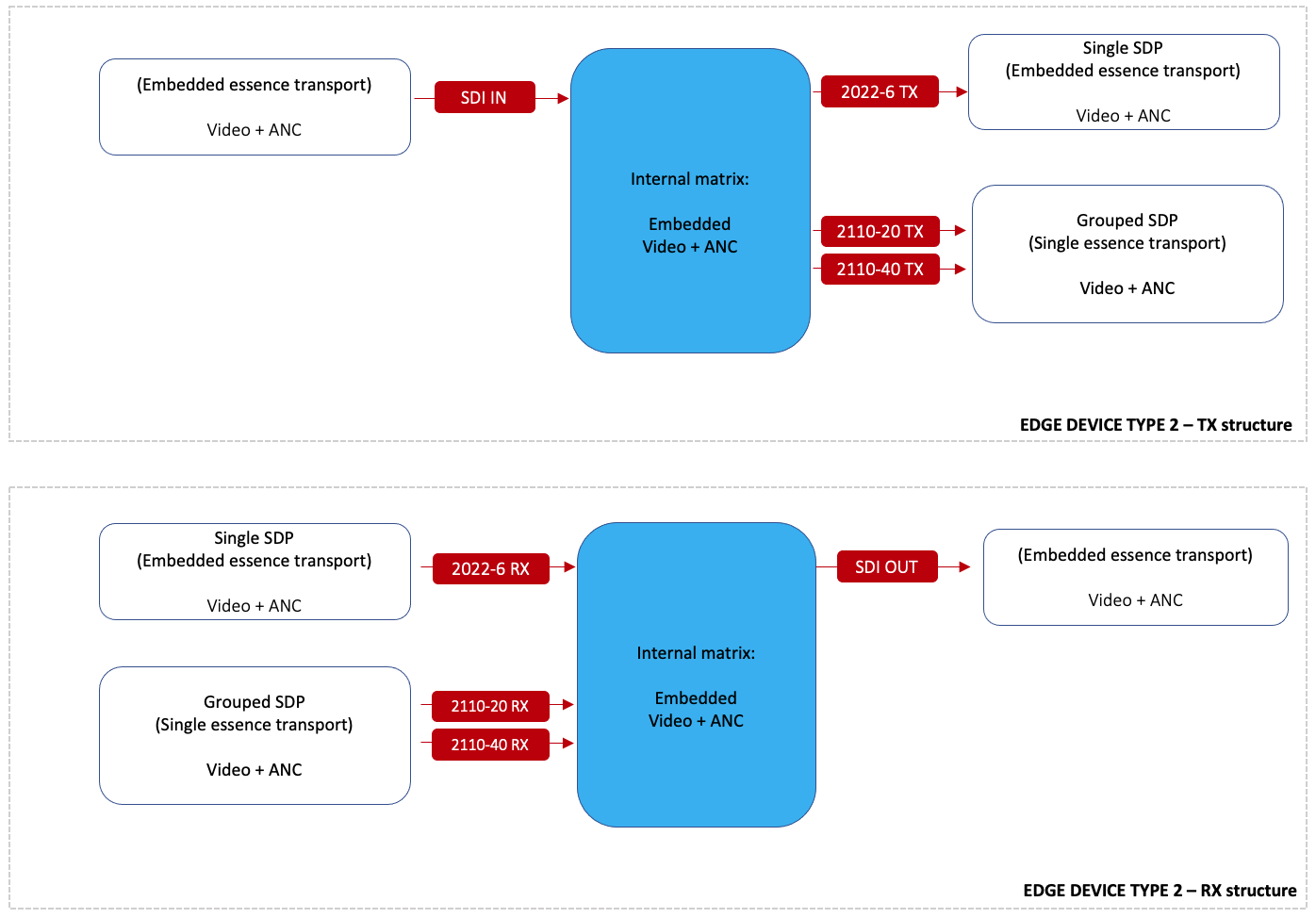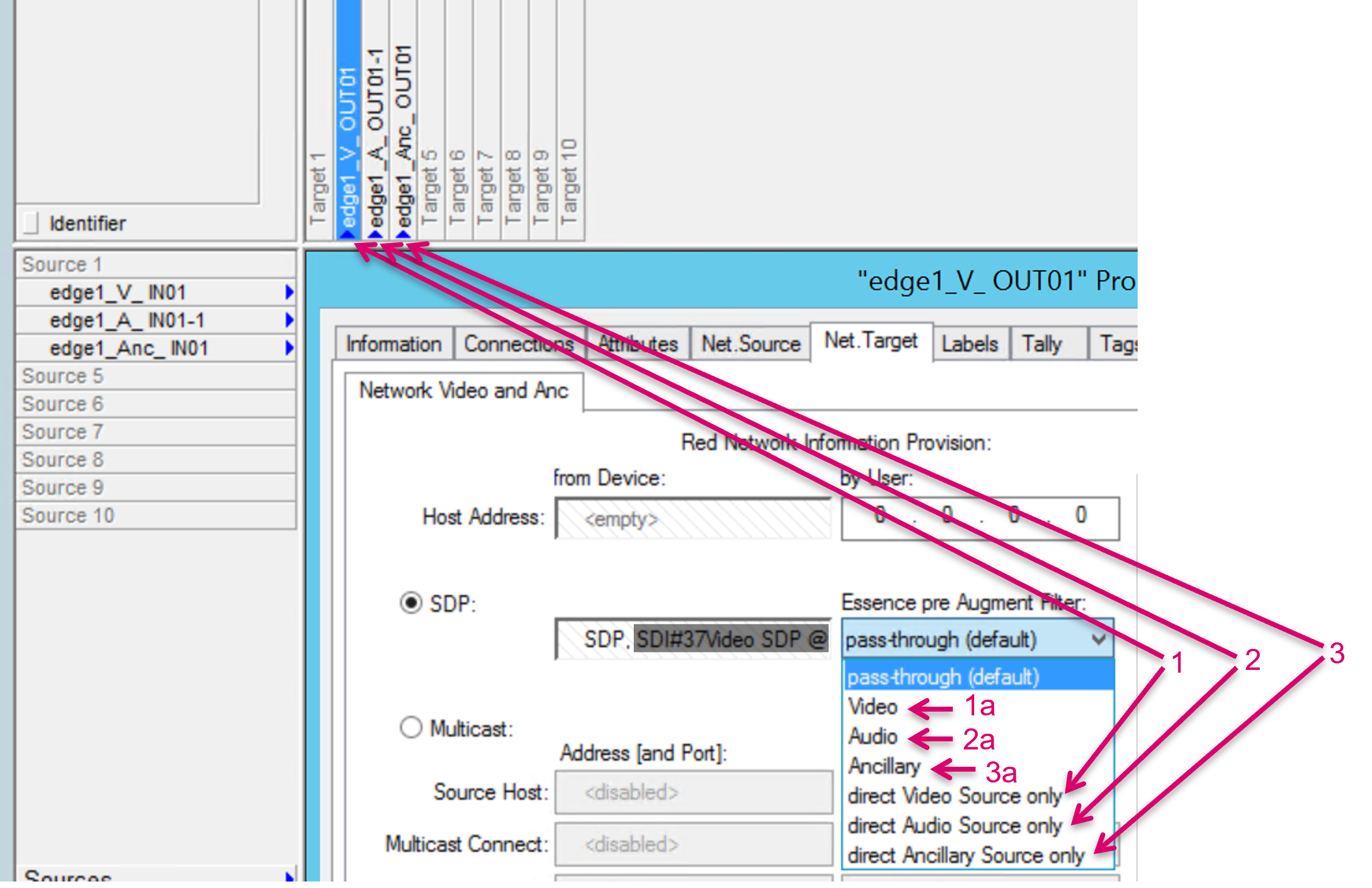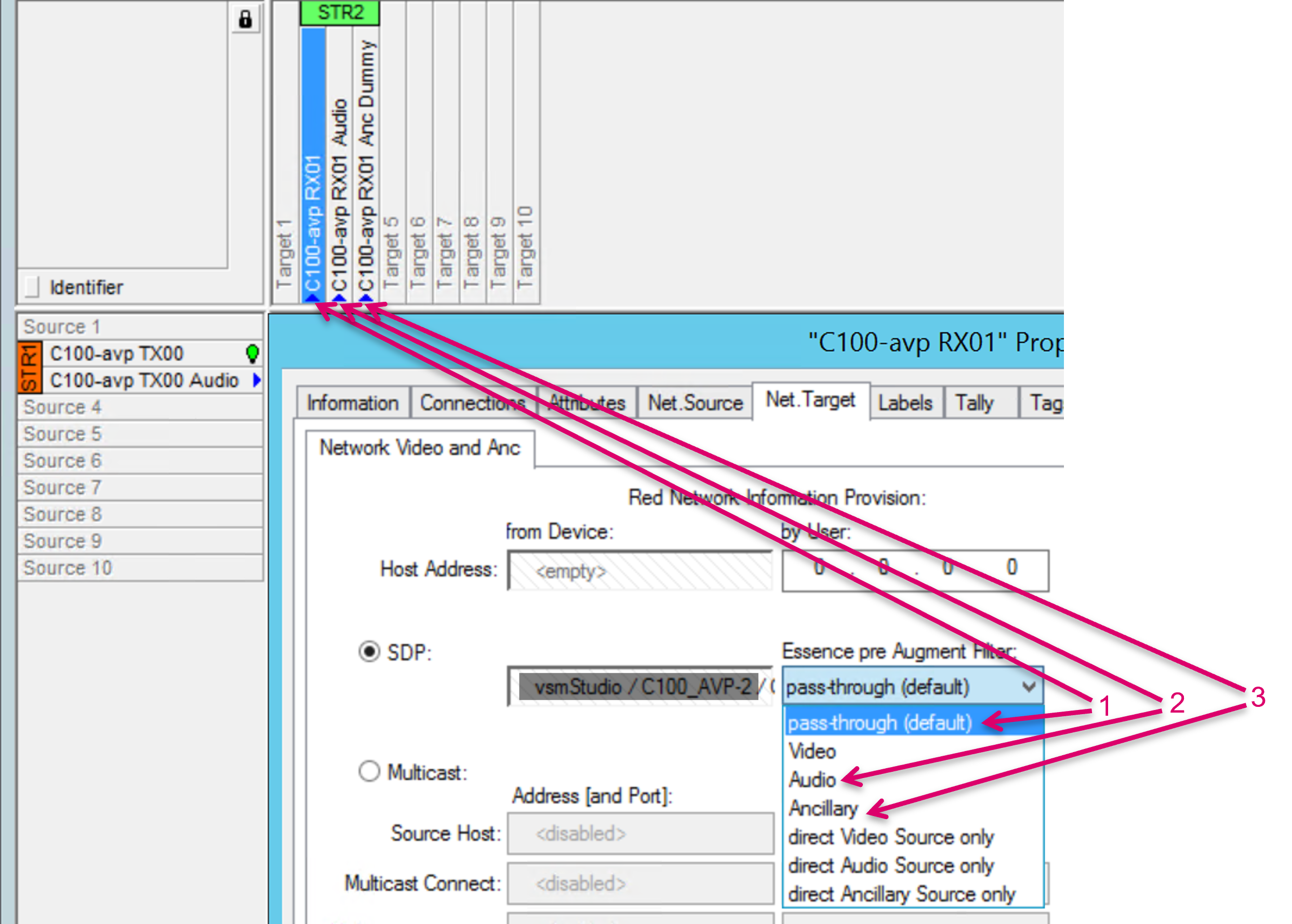HowTo - Media Essence Filtering
Media Essence Filtering was introduced in the first place to support hybrid IP and baseband systems, where the filter adds the crucial feature set to manage 2110 stream essence transport for an end-to-end single step routing workflow.
Introduction
Media Essence Transport Types
Other than in baseband and 2022-6 the ancillary data is always embedded inside the video content, with 2110 essence transport two type of SDP handling have been established. Although Audio should be considered in this context as well, the following examples only focus on the more common application, where 2110-20 and 2110-40 essences are grouped.


Use Case - Hybrid System
In order to achieve a single step routing workflow, the Media Essence Filter is used to apply TYPE specific SDP treatment for ANC and Video essences. The VSM routing engine utilizes grouped SDPs for both essences as the general basis for its network routing process. Individual 2110 essence SDPs for TYPE-1 devices will be pre-grouped by the Media Essence Filter before being routed. On the destination side, the media essence filter will split the grouped SDP back into individual Video and ANC essence SDPs for all individual essence receivers.

2110-40 ANC SDPs do not carry video format related information. On a joint Video and ANC patch vsmStudio is therefore not capable to automatically verify if the individual essence formats line up with each other. It depends on the controlled edge devices whether it can cope with any essence format mismatch.
Setup in vsmStudio
This guide shows configuration examples for the Media Essence Filter for TYPE-1 (e.g., a Lawo .edge) and TYPE-2 (e.g., Lawo V_matrix C100 vm_avp) devices.
- In order to make use of the essence filter it is mandatory that Video and ANC Signal Paths are located on one common layer in vsmStudio.
- The essence filter is based on the Pseudo rule feature within vsmStudio, which requires a valid license.
- Virtual Signals cannot be used in combination with the Media Essence Filter. Currently only physical signals are supported.
TYPE-1 - Example: A Gateway with separate essence SDPs
Signal Path setup for Stream Transmitter
This type of device supports separate essence SDPs. On the Transmitter/Source side, the Media Essence Filter combines Video, ANC and Audio essence SDPs into one grouped SDP. After creating all required Signal Paths for the 2110 Transmitter essences and dropping the respective SDP parameters, following settings are required:
- In the Signal Path properties for the Video stream, the Essence pre Augment Filter is set to "Video" (1).
- In the Signal Path properties for the Audio stream(s), the Essence pre Augment Filter is set to "Audio" (2).
- In the Signal Path properties for the ANC stream, the Essence pre Augment Filter is set to "Ancillary" (3).

A Pseudo Device rule has to be created with the Trigger being the Network Video TX Signal Path assigned to the Video column (1), the Network Anc TX Signal assigned to the Anc column (2) and the Network Audio TX Signal Path(s) assigned to the respective Audio columns (3).

Signal Path setup for Stream Receiver
This type of device supports separate essence SDPs. On the Receiver/Target side, the Media Essence Filter splits Video, ANC and Audio essence SDPs into individual essence SDPs. After creating all required Signal Paths for the 2110 Receiver essences and dropping the respective SDP parameters, following default settings are required:
- In the Signal Path properties for the Video RX stream, the Essence pre Augment Filter is set to "direct Video Source only" (1).
- In the Signal Path properties for the Audio RX stream(s), the Essence pre Augment Filter is set to "direct Audio Source only" (2).
In the Signal Path properties for the ANC RX stream, the Essence pre Augment Filter is set to "direct Ancillary Source only" (3).
The above settings force the specific target to only use the essence filter on the directly connected signal and to not extract the essence from e.g. a Pseudo Device parent.
In case the specific Receiver Target essences should be enabled to also receive SDP data that may be an extract from the Pseudo Device Parent's Filter, the alternative, following settings are required:
- In the Signal Path properties for the Video RX stream, the Essence pre Augment Filter is set to "Video" (1a).
- In the Signal Path properties for the Audio RX stream(s), the Essence pre Augment Filter is set to "Audio" (2a).
- In the Signal Path properties for the ANC RX stream, the Essence pre Augment Filter is set to "Ancillary" (3a).
 A Pseudo Device rule has to be created with the Trigger being the Network Video RX Signal Path assigned to the Video column (1), the Network Anc RX Signal assigned to the Anc column (2) and the Network Audio RX Signal Path(s) assigned to the respective Audio columns (3).
A Pseudo Device rule has to be created with the Trigger being the Network Video RX Signal Path assigned to the Video column (1), the Network Anc RX Signal assigned to the Anc column (2) and the Network Audio RX Signal Path(s) assigned to the respective Audio columns (3).

In terms of Lawo V_matrix C100, the vm_dmv receivers are, different to vm_avp receivers, TYPE-1 devices. If the Distributed Multi Viewer module is used, no manual Filter settings are required.
TYPE-2 - Example: A Gateway with grouped SDPs including multiple essence SDP
Signal Path setup for Stream Transmitter
This type of device supports grouped essence SDPs, so on the Transmitter side, e.g., Video and ANC essence SDPs are already merged into one grouped SDP. The combining feature of the Media Essence Filter is not actively involved. Based on the example of a grouped Video and ANC SDP, after creating all required Signal Paths for the "physically existing" 2110 Transmitter essences and dropping the respective SDP parameters, following settings are required:
- In the Signal Path properties for the Video TX stream, the Essence pre Augment Filter is set to "pass-through (default)" (1).
- In the Signal Path properties for the Audio TX stream(s), the Essence pre Augment Filter is set to "Audio" (2).
 A Pseudo Device rule has to be created with the Trigger being the Network Video TX Signal Path assigned to the Video column (1). Afterwards, the same Network Video TX Signal Path is assigned to the Anc column (2). The Network Audio TX Signal Path(s) are assigned to the respective Audio columns (3).
A Pseudo Device rule has to be created with the Trigger being the Network Video TX Signal Path assigned to the Video column (1). Afterwards, the same Network Video TX Signal Path is assigned to the Anc column (2). The Network Audio TX Signal Path(s) are assigned to the respective Audio columns (3).

Signal Path setup for Stream Receiver
This type of device supports grouped essence SDP which are either already grouped within the device of same Type or merged by the Media Essence Filter on the TX side. Based on the example of a grouped Video and ANC SDP, after creating all required Signal Paths for the "physically existing" 2110 Receiver essences and dropping the respective SDP parameters, following settings are required:
- In the Signal Path properties for the Video RX stream, the Essence pre Augment Filter is set to "pass-through (default)" (1).
- In the Signal Path properties for the Audio RX stream(s), the Essence pre Augment Filter is set to "Audio" (2).
Only in the special case of an SDN controlled network, there is the need to have dedicated target Signal Paths for each essence, even there is no separate SDP parameter available to be assigned. In this case, a "Dummy" Signal Path Target has to be created and assigned accordingly:
- In the Signal Path properties for the "Dummy" ANC RX stream, the Essence pre Augment Filter is set to "Ancillary" (3).
 A Pseudo Device rule has to be created with the Trigger being the Network Video RX Signal Path assigned to the Video column (1), the Anc column remains unassigned (2) and the Network Audio RX Signal Path(s) are assigned to the respective Audio columns (3).
A Pseudo Device rule has to be created with the Trigger being the Network Video RX Signal Path assigned to the Video column (1), the Anc column remains unassigned (2) and the Network Audio RX Signal Path(s) are assigned to the respective Audio columns (3).
 In the special case of an SDN controlled network, there is the need to have dedicated target Signal Paths for each essence, even there is no separate SDP parameter available to be assigned. In this case, a "Dummy" Signal Path Target has to be created and assigned accordingly. In this case the Pseudo Device rule has to be created with the Trigger being the Network Video RX Signal Path assigned to the Video column (1), the ANC RX "Dummy" Signal Path assigned to the Anc column (2) and the Network Audio RX Signal Path(s) are assigned to the respective Audio columns (3).
In the special case of an SDN controlled network, there is the need to have dedicated target Signal Paths for each essence, even there is no separate SDP parameter available to be assigned. In this case, a "Dummy" Signal Path Target has to be created and assigned accordingly. In this case the Pseudo Device rule has to be created with the Trigger being the Network Video RX Signal Path assigned to the Video column (1), the ANC RX "Dummy" Signal Path assigned to the Anc column (2) and the Network Audio RX Signal Path(s) are assigned to the respective Audio columns (3).
